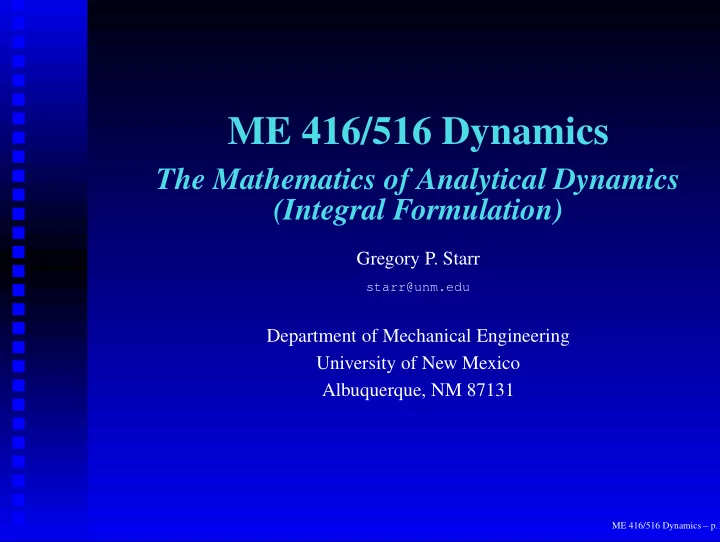

ME 416/516 Dynamics The Mathematics of Analytical Dynamics (Integral Formulation) Gregory P. Starr starr@unm.edu Department of Mechanical Engineering University of New Mexico Albuquerque, NM 87131 ME 416/516 Dynamics – p.1
Stationary Values of a Definite Integral We wish to minimize the following integral I : � x = b F ( x, y, y ′ ) dx ( y ′ = dy I = dx ) (1) x = a where I is a functional , and y ( x ) is the unique function that results in the minimum for I ... Consider the varied function (see text Fig. B.1) y ( x ) + ǫη ( x ) , where η ( a ) = η ( b ) = 0 So � x = b F ( x, y + ǫη, y ′ + ǫη ′ ) dx I ( ǫ ) = (2) x = a ME 416/516 Dynamics – p.2
For integral I to have a stationary value, dI dǫ = 0 when ǫ = 0 (3) This results in � b � dI ∂F ∂F � ∂y ′ η ′ = ∂y η + dx = 0 (4) � dǫ � a ǫ =0 � �� � integrate by parts ME 416/516 Dynamics – p.3
Recall integration by parts is � � udv = uv − vdu (5) (6) We want to integrate � b ∂F ∂y ′ η ′ dx. (7) a and a good choice for u and dv is u = ∂F ∂y ′ , dv = η ′ dx (8) ME 416/516 Dynamics – p.4
Then since � ∂F � u = ∂F ⇒ du = d ∂y ′ = dx (9) dx ∂y ′ also dv = η ′ dx = dη dx dx = dη = ⇒ v = η (10) Our integral is thus � b � b � � ∂F � x = b [ ⋆ ] = ∂F d � ∂y ′ η ( x ) − η ( x ) dx (11) � dx ∂y ′ � a a x = a ME 416/516 Dynamics – p.5
Getting back to the “stationary value” problem... � x = b � � � ∂F � ∂F �� x = b dI = ∂F ∂y − d � � ∂y ′ η ( x ) + η ( x ) dx = 0 � � dǫ dx ∂y ′ � � x = a ǫ =0 x = a � �� � η ( a )= η ( b )=0 (12) Since function η ( x ) is arbitrary , we must have � ∂F � ∂F ∂y − d = 0 (13) dx ∂y ′ This is the famous “Euler-Lagrange” equation! ME 416/516 Dynamics – p.6
Application to Dynamics Newton’s 2 nd law is given by F = ˙ p (14) where p = m v (momentum) (15) D’Alembert’s principle is F − ˙ p = 0 = ⇒ ( F − ˙ p ) · δ r = 0 (16) Equation (16) holds at each instant of time, so � t 2 ( F − ˙ p ) · δ r dt = 0 (17) t 1 ME 416/516 Dynamics – p.7
Integrate the 2 nd term by parts ( 1 st term is simply δW ): � t 2 − p · δ r dt ˙ (18) t 1 Select the following for u and dv : ⇒ du = d u = δ r = dtδ r dt (19) � dv = ˙ p dt = ⇒ v = p dt = p ˙ (20) Thus we have � t 2 � t 2 � � p · d p · δ r dt = − p · δ r | t 2 − t 1 + ˙ dtδ r dt (21) t 1 t 1 ME 416/516 Dynamics – p.8
The 2 nd term in (21) can be expanded � t 2 � t 2 � � p · d dt = p · δ ˙ r dt = dtδ r (22) t 1 t 1 � t 2 � t 2 p · δ v dt = m v · δ v dt (23) t 1 t 1 But T = 1 2 m v · v , so δT = m v · δ v , and combining everything we get � t 2 ( δW + δT ) dt = − p · δ r | t 2 t 1 = 0 (24) t 1 Like η ( x ) , let δ r ( t 1 ) = δ r ( t 2 ) = 0 , then we get... ME 416/516 Dynamics – p.9
� t 2 ( δW + δT ) = 0 (25) t 1 This is the “Extended Hamilton’s Principle!” For conservative forces, δW = − δV , so we have � t 2 ( δT − δV ) dt = 0 (26) t 1 ME 416/516 Dynamics – p.10
Cleaning it Up... Define L = T − V, (27) then we have � t 2 � t 2 δL dt = 0 = ⇒ δ Ldt = 0 (28) t 1 t 1 Equation (28) implies a STATIONARY VALUE of the integral, and we know how to do that! F ( x, y, y ′ ) = ⇒ L ( q, ˙ q, t ) (29) ME 416/516 Dynamics – p.11
Equations of Motion Using equation (13), the Euler-Lagrange equation, we have � ∂L � d − ∂L ∂q = 0 (30) ∂ ˙ dt q = Q nc (for nonconservative forces) (31) Another formulation: � ∂T � d − ∂T + ∂V = Q knc , k = 1 , 2 , ...n ∂ ˙ dt q k ∂q k ∂q k (32) ME 416/516 Dynamics – p.12
The End I hope you enjoyed the show! ME 416/516 Dynamics – p.13
Recommend
More recommend